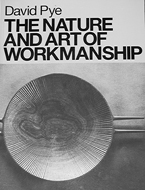 The word, “workmanship” in the title of this book may have raised your curiosity. If I then told you that the author, David Pye, was Professor of Furniture Design at the Royal College of Art, London, you might be scratching your head wondering, “What does this have to do with stone sculpture?” Let me explain. In addition to his role as Professor of Furniture Design, Pye was also an architect, industrial designer and master craftsman. During his long and illustrious career, he devoted a great deal of thought to process of design and the execution of those designs. In recognition of the corruption of the terms “craft” and “craftsmanship” over the years, he dismisses them, and proposes new (and probably more useful) terminology – the ‘workmanship of risk’ and the ‘workmanship of certainty,’ Workmanship of risk means a quality of work dependent on the judgment, dexterity and care with which one works, and workmanship of certainly involves predetermined results before a thing is made, such as in automated production. Risk carries with it the chance that any work piece could be damaged or destroyed at any step in its handling and does not matter whether the tool is a simple hammer or complex milling machine. Either a reliable process or fallible workman defines the result.
The word, “workmanship” in the title of this book may have raised your curiosity. If I then told you that the author, David Pye, was Professor of Furniture Design at the Royal College of Art, London, you might be scratching your head wondering, “What does this have to do with stone sculpture?” Let me explain. In addition to his role as Professor of Furniture Design, Pye was also an architect, industrial designer and master craftsman. During his long and illustrious career, he devoted a great deal of thought to process of design and the execution of those designs. In recognition of the corruption of the terms “craft” and “craftsmanship” over the years, he dismisses them, and proposes new (and probably more useful) terminology – the ‘workmanship of risk’ and the ‘workmanship of certainty,’ Workmanship of risk means a quality of work dependent on the judgment, dexterity and care with which one works, and workmanship of certainly involves predetermined results before a thing is made, such as in automated production. Risk carries with it the chance that any work piece could be damaged or destroyed at any step in its handling and does not matter whether the tool is a simple hammer or complex milling machine. Either a reliable process or fallible workman defines the result.
 As Pye says, “Bad workmanship is a matter of making mistakes through hurry, carelessness or ineptitude, which thwart the design.”
As Pye says, “Bad workmanship is a matter of making mistakes through hurry, carelessness or ineptitude, which thwart the design.”
Through many examples, photographs and theory, Pye explains how to judge the value of work – whether one’s own or that of others. In his down-to-earth writing style, he shows how to judge good workmanship from bad, Further, he distinguishes “regulated” from “free” fabrication where fine tolerances and precise geometries characterize regulated fabrication; whereas free fabrication allows the worker to vary the workpiece for aesthetic reasons.
Without mentioning stone sculpture directly, everything Pye discusses has relevance for our craft. His book might lead to some interesting discussions over the camp fire at one of our symposia. It would certainly generate thoughtful ruminations in our own studios.

